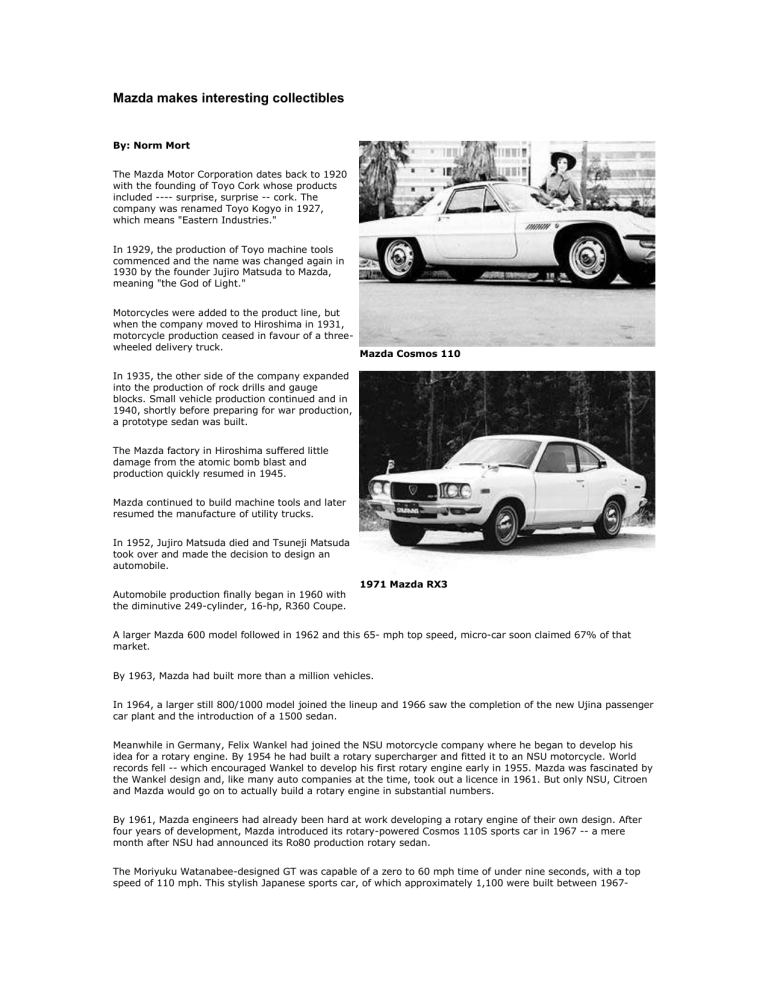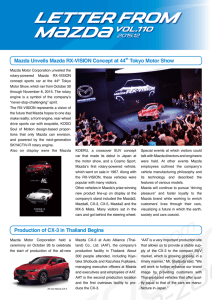Mazda makes interesting collectibles

Mazda makes interesting collectibles
By: Norm Mort
The Mazda Motor Corporation dates back to 1920 with the founding of Toyo Cork whose products included ---- surprise, surprise -- cork. The company was renamed Toyo Kogyo in 1927, which means "Eastern Industries."
In 1929, the production of Toyo machine tools commenced and the name was changed again in
1930 by the founder Jujiro Matsuda to Mazda, meaning "the God of Light."
Motorcycles were added to the product line, but when the company moved to Hiroshima in 1931, motorcycle production ceased in favour of a threewheeled delivery truck.
Mazda Cosmos 110
In 1935, the other side of the company expanded into the production of rock drills and gauge blocks. Small vehicle production continued and in
1940, shortly before preparing for war production, a prototype sedan was built.
The Mazda factory in Hiroshima suffered little damage from the atomic bomb blast and production quickly resumed in 1945.
Mazda continued to build machine tools and later resumed the manufacture of utility trucks.
In 1952, Jujiro Matsuda died and Tsuneji Matsuda took over and made the decision to design an automobile.
Automobile production finally began in 1960 with the diminutive 249-cylinder, 16-hp, R360 Coupe.
1971 Mazda RX3
A larger Mazda 600 model followed in 1962 and this 65- mph top speed, micro-car soon claimed 67% of that market.
By 1963, Mazda had built more than a million vehicles.
In 1964, a larger still 800/1000 model joined the lineup and 1966 saw the completion of the new Ujina passenger car plant and the introduction of a 1500 sedan.
Meanwhile in Germany, Felix Wankel had joined the NSU motorcycle company where he began to develop his idea for a rotary engine. By 1954 he had built a rotary supercharger and fitted it to an NSU motorcycle. World records fell -- which encouraged Wankel to develop his first rotary engine early in 1955. Mazda was fascinated by the Wankel design and, like many auto companies at the time, took out a licence in 1961. But only NSU, Citroen and Mazda would go on to actually build a rotary engine in substantial numbers.
By 1961, Mazda engineers had already been hard at work developing a rotary engine of their own design. After four years of development, Mazda introduced its rotary-powered Cosmos 110S sports car in 1967 -- a mere month after NSU had announced its Ro80 production rotary sedan.
The Moriyuku Watanabee-designed GT was capable of a zero to 60 mph time of under nine seconds, with a top speed of 110 mph. This stylish Japanese sports car, of which approximately 1,100 were built between 1967-
1970, was never marketed in Canada, although four have since been imported into North America and one example is in the hands of Mazda Canada.
Also introduced in 1967 was a new 1000/1200 model and this was followed in 1968 by the world's first high volume, rotary-powered car --the R100 Coupe.
It was this model that first arrived in Canada in 1968. By 1972, Mazda had built over five million units and by
1973 one million had been exported. In 1971, Mazda began to supply Ford with a version of its Courier pickup truck.
The R100 was followed by the RX2 (1970), the RX3 (1971) and finally the RX4 (1973). (The RX3 sedan, coupe and wagon were also available as combustion-engine models in Canada and known as the 808.)
The stylish, rotary-engined cars with sparkling performance proved to be popular, but when the first Middle East oil crisis hit in the mid-'70s, the sale of Mazda's less fuel efficient rotary cars dropped dramatically in the face of rocketing gas prices.
The combustion engine GLC (Great Little Car) or 323 (1977) was introduced and proved to be the company's turning point.
Mazda continued to show it had great faith in rotary power when it introduced the revolutionary RX7 sports car in
1978. Rotary engine sedans also continued to be built in Japan; production totalled one million rotary-powered units.
Mazda continued to introduce new models in the 1980s. The first 323 FWD model appeared in 1980 and was named "Car of The Year" in Japan. The new 626 of 1982 also claimed this award.
Like most Japanese cars, there is only moderate collectible interest. The RX7 Mazda sports cars are the most desirable models and the rotary engines have proven very reliable.
Good club support helps assure parts are available and members can recommend competent service, but your local Mazda dealer can often fix even the earliest of models. Clean examples can be found at under the $10,000 mark, although a very clean second generation RX7 convertible can command slightly more.
The neat rotary sedans, coupes and wagon are rarely seen, but they make a fun and fascinating collectible for very little money.


